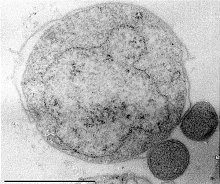DPANN

| Domaine | Archaea |
|---|
C. Rinke et al. (2013)
Taxons de rang inférieur
Les DPANN forment un clade constituant un super-embranchement d'archées. Il a identifié en 2013[1]. On le considère aujourd'hui comme la branche la plus basale de l'arbre des archées[2].
DPANN est un sigle basé sur les noms des cinq premiers groupes découverts, les Diapherotrites, Parvarchaeota, Aenigmarchaeota, Nanoarchaeota et Nanohaloarchaeota. Par la suite, les Woesearchaeota, Pacearchaeota[3] puis les Altiarchaeota[4], Micrarchaeota et Mamarchaeota[5] y ont été ajoutés.
Les DPANN regroupent des embranchements divers par leur milieu et leur métabolisme, allant des formes symbiotiques et thermophiles telles que Nanoarchaeota, des acidophiles comme Parvarchaeota et des non extrémophiles comme Aenigmarchaeota et Diapherotrites. Les DPANN ont également été détectés dans des eaux souterraines riches en nitrates, à la surface de l'eau mais pas en dessous, ce qui indique que ces taxons sont encore assez difficiles à localiser[6].
Cladogramme
[modifier | modifier le code]D'après Tom A. Williams et al., 2017[2] et Castelle & Banfield, 2018[5] (DPANN) :
| Neomura |
| ||||||||||||||||||||||||||||||||||||||||||||||||||||||||||||||||||||||||||||||||||||||||||||||||||||||||||||||||||||||||||||||||||||||||||||||||||||||||||||||||||||||||||||||||||||||||||||||||||||||||||||||||||
Notes et références
[modifier | modifier le code]- (en) Rinke C, Schwientek P, Sczyrba A, Ivanova NN, Anderson IJ, Cheng JF, Darling A, Malfatti S, Swan BK, Gies EA, Dodsworth JA, Hedlund BP, Tsiamis G, Sievert SM, Liu WT, Eisen JA, Hallam SJ, Kyrpides NC, Stepanauskas R, Rubin EM, Hugenholtz P, Woyke T, « Insights into the phylogeny and coding potential of microbial dark matter », Nature, vol. 499, no 7459, , p. 431–437 (PMID 23851394, DOI 10.1038/nature12352, lire en ligne)
- (en) Tom A. Williams et al., Integrative modeling of gene and genome evolution roots the archaeal tree of life, publié en 2017 DOI 10.1073/pnas.1618463114
- Castelle CJ, Wrighton KC, Thomas BC, Hug LA, Brown CT, Wilkins MJ, Frischkorn KR, Tringe SG, Singh A, Markillie LM, Taylor RC, Williams KH, Banfield JF, « Genomic expansion of domain archaea highlights roles for organisms from new phyla in anaerobic carbon cycling », Current Biology, vol. 25, no 6, , p. 690–701 (PMID 25702576, DOI 10.1016/j.cub.2015.01.014)
- Anja Spang, Eva F. Caceres et Thijs J. G. Ettema, « Genomic exploration of the diversity, ecology, and evolution of the archaeal domain of life », Science, vol. 357, no 6351, , eaaf3883 (PMID 28798101, DOI 10.1126/science.aaf3883)
- (en) Castelle, C.J., Banfield, J.F., « Major New Microbial Groups Expand Diversity and Alter our Understanding of the Tree of Life », Cell, vol. 172, no 6, , p. 1181-1197 (PMID 29522741, DOI 10.1016/j.cell.2018.02.016)
- Ludington WB, Seher TD, Applegate O, Li X, Kliegman JI, Langelier C, Atwill ER, Harter T, DeRisi JL, « Assessing biosynthetic potential of agricultural groundwater through metagenomic sequencing: A diverse anammox community dominates nitrate-rich groundwater », PLOS ONE, vol. 12, no 4, , e0174930 (PMID 28384184, PMCID 5383146, DOI 10.1371/journal.pone.0174930)
- (en) Kiley W. Seitz, Nina Dombrowski, Laura Eme, Anja Spang, Jonathan Lombard et al., « Asgard archaea capable of anaerobic hydrocarbon cycling », Nature Communications, vol. 10, , article no 1822 (DOI 10.1038/s41467-019-09364-x).
